Nutritional Labelling Analysis: A Comparative Study of Food Products
VerifiedAdded on 2021/11/13
|11
|3002
|54
Homework Assignment
AI Summary
This assignment provides a detailed analysis of the nutritional information found on the labels of three different food products: Dairyland chocolate milk, Dairyland homogenized milk, and Wonder Bread. The analysis includes a breakdown of serving sizes, calorie counts, and the amounts of various nutrients such as carbohydrates, fats, proteins, vitamins, and minerals. The student calculates the calories derived from fat, carbohydrates, and protein for each product based on a serving size. The assignment also discusses the primary ingredients, the impact of each food product on health, and the potential health implications of consuming these foods regularly, considering factors like sugar, saturated fat, sodium, and potassium content. Finally, the student reflects on the positive and negative aspects of each food product, considering the impact on their diet and making recommendations for future consumption.
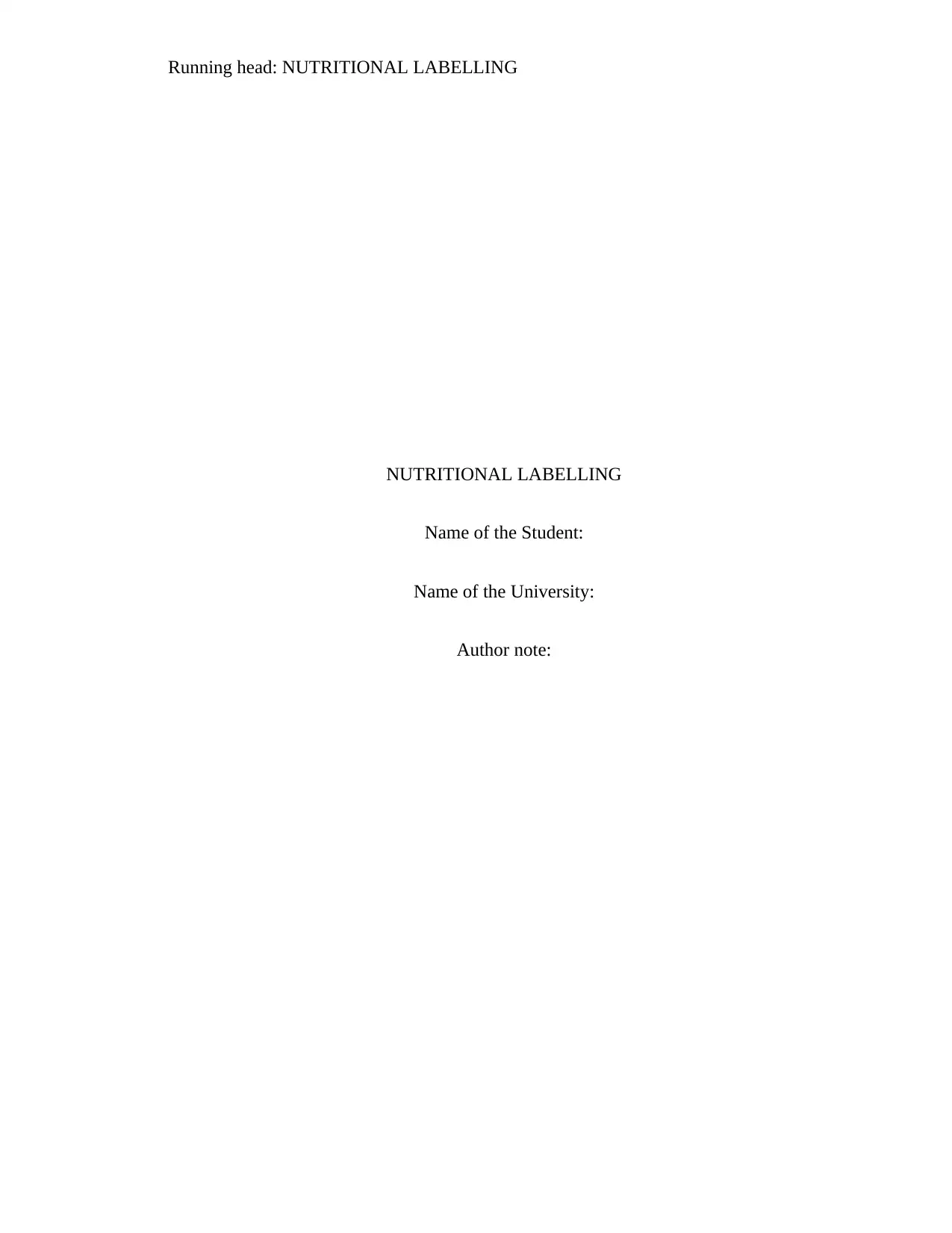
Running head: NUTRITIONAL LABELLING
NUTRITIONAL LABELLING
Name of the Student:
Name of the University:
Author note:
NUTRITIONAL LABELLING
Name of the Student:
Name of the University:
Author note:
Paraphrase This Document
Need a fresh take? Get an instant paraphrase of this document with our AI Paraphraser
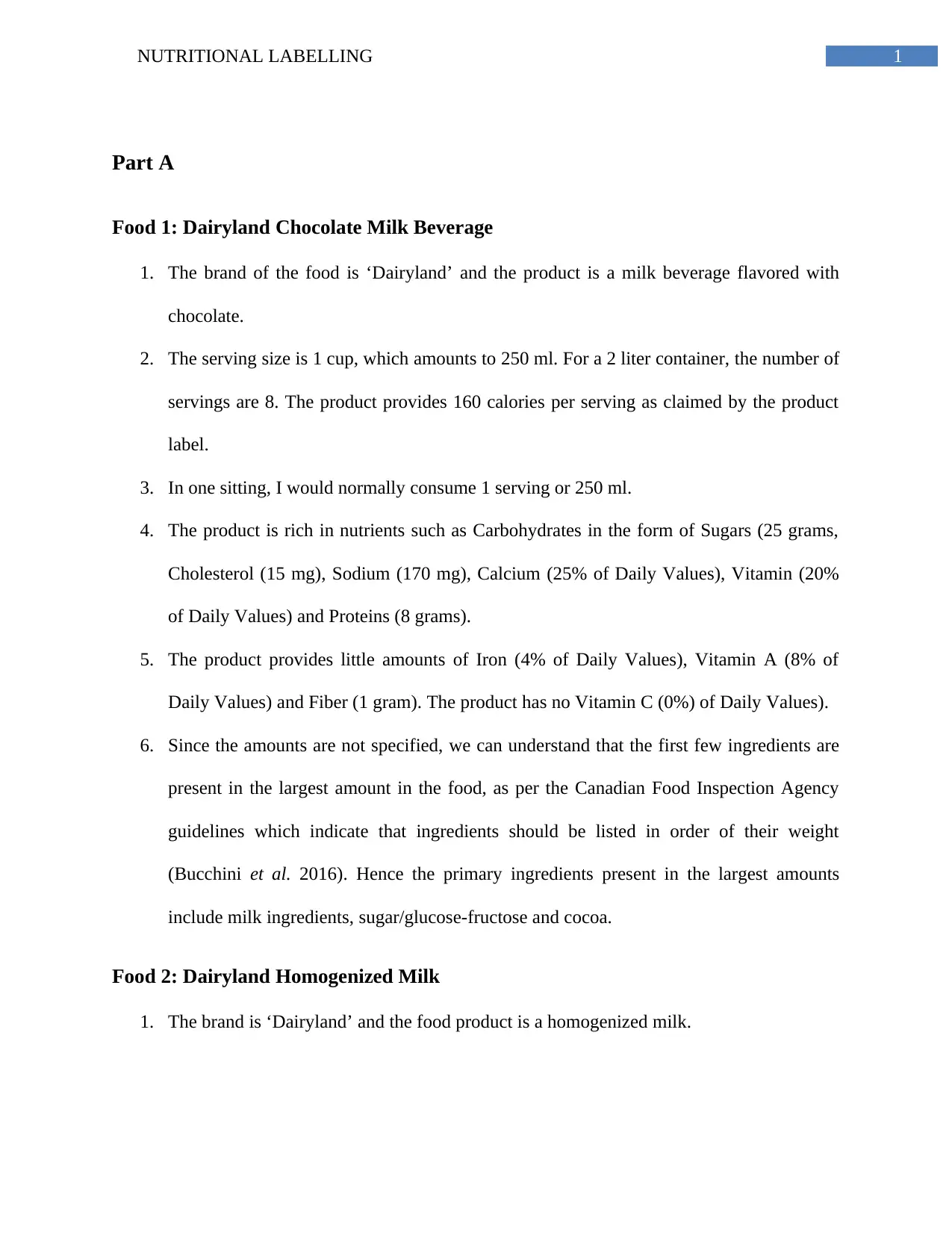
1NUTRITIONAL LABELLING
Part A
Food 1: Dairyland Chocolate Milk Beverage
1. The brand of the food is ‘Dairyland’ and the product is a milk beverage flavored with
chocolate.
2. The serving size is 1 cup, which amounts to 250 ml. For a 2 liter container, the number of
servings are 8. The product provides 160 calories per serving as claimed by the product
label.
3. In one sitting, I would normally consume 1 serving or 250 ml.
4. The product is rich in nutrients such as Carbohydrates in the form of Sugars (25 grams,
Cholesterol (15 mg), Sodium (170 mg), Calcium (25% of Daily Values), Vitamin (20%
of Daily Values) and Proteins (8 grams).
5. The product provides little amounts of Iron (4% of Daily Values), Vitamin A (8% of
Daily Values) and Fiber (1 gram). The product has no Vitamin C (0%) of Daily Values).
6. Since the amounts are not specified, we can understand that the first few ingredients are
present in the largest amount in the food, as per the Canadian Food Inspection Agency
guidelines which indicate that ingredients should be listed in order of their weight
(Bucchini et al. 2016). Hence the primary ingredients present in the largest amounts
include milk ingredients, sugar/glucose-fructose and cocoa.
Food 2: Dairyland Homogenized Milk
1. The brand is ‘Dairyland’ and the food product is a homogenized milk.
Part A
Food 1: Dairyland Chocolate Milk Beverage
1. The brand of the food is ‘Dairyland’ and the product is a milk beverage flavored with
chocolate.
2. The serving size is 1 cup, which amounts to 250 ml. For a 2 liter container, the number of
servings are 8. The product provides 160 calories per serving as claimed by the product
label.
3. In one sitting, I would normally consume 1 serving or 250 ml.
4. The product is rich in nutrients such as Carbohydrates in the form of Sugars (25 grams,
Cholesterol (15 mg), Sodium (170 mg), Calcium (25% of Daily Values), Vitamin (20%
of Daily Values) and Proteins (8 grams).
5. The product provides little amounts of Iron (4% of Daily Values), Vitamin A (8% of
Daily Values) and Fiber (1 gram). The product has no Vitamin C (0%) of Daily Values).
6. Since the amounts are not specified, we can understand that the first few ingredients are
present in the largest amount in the food, as per the Canadian Food Inspection Agency
guidelines which indicate that ingredients should be listed in order of their weight
(Bucchini et al. 2016). Hence the primary ingredients present in the largest amounts
include milk ingredients, sugar/glucose-fructose and cocoa.
Food 2: Dairyland Homogenized Milk
1. The brand is ‘Dairyland’ and the food product is a homogenized milk.
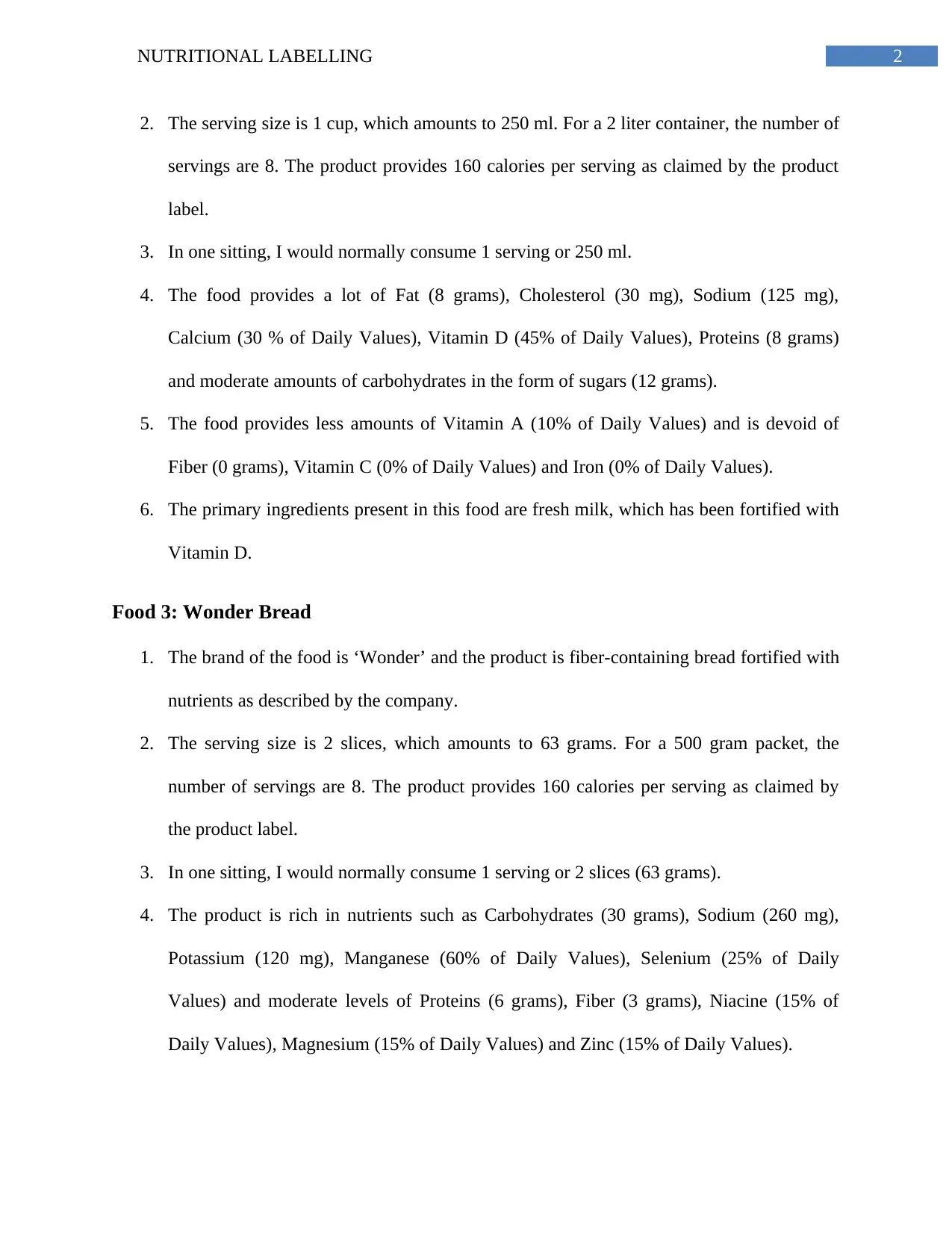
2NUTRITIONAL LABELLING
2. The serving size is 1 cup, which amounts to 250 ml. For a 2 liter container, the number of
servings are 8. The product provides 160 calories per serving as claimed by the product
label.
3. In one sitting, I would normally consume 1 serving or 250 ml.
4. The food provides a lot of Fat (8 grams), Cholesterol (30 mg), Sodium (125 mg),
Calcium (30 % of Daily Values), Vitamin D (45% of Daily Values), Proteins (8 grams)
and moderate amounts of carbohydrates in the form of sugars (12 grams).
5. The food provides less amounts of Vitamin A (10% of Daily Values) and is devoid of
Fiber (0 grams), Vitamin C (0% of Daily Values) and Iron (0% of Daily Values).
6. The primary ingredients present in this food are fresh milk, which has been fortified with
Vitamin D.
Food 3: Wonder Bread
1. The brand of the food is ‘Wonder’ and the product is fiber-containing bread fortified with
nutrients as described by the company.
2. The serving size is 2 slices, which amounts to 63 grams. For a 500 gram packet, the
number of servings are 8. The product provides 160 calories per serving as claimed by
the product label.
3. In one sitting, I would normally consume 1 serving or 2 slices (63 grams).
4. The product is rich in nutrients such as Carbohydrates (30 grams), Sodium (260 mg),
Potassium (120 mg), Manganese (60% of Daily Values), Selenium (25% of Daily
Values) and moderate levels of Proteins (6 grams), Fiber (3 grams), Niacine (15% of
Daily Values), Magnesium (15% of Daily Values) and Zinc (15% of Daily Values).
2. The serving size is 1 cup, which amounts to 250 ml. For a 2 liter container, the number of
servings are 8. The product provides 160 calories per serving as claimed by the product
label.
3. In one sitting, I would normally consume 1 serving or 250 ml.
4. The food provides a lot of Fat (8 grams), Cholesterol (30 mg), Sodium (125 mg),
Calcium (30 % of Daily Values), Vitamin D (45% of Daily Values), Proteins (8 grams)
and moderate amounts of carbohydrates in the form of sugars (12 grams).
5. The food provides less amounts of Vitamin A (10% of Daily Values) and is devoid of
Fiber (0 grams), Vitamin C (0% of Daily Values) and Iron (0% of Daily Values).
6. The primary ingredients present in this food are fresh milk, which has been fortified with
Vitamin D.
Food 3: Wonder Bread
1. The brand of the food is ‘Wonder’ and the product is fiber-containing bread fortified with
nutrients as described by the company.
2. The serving size is 2 slices, which amounts to 63 grams. For a 500 gram packet, the
number of servings are 8. The product provides 160 calories per serving as claimed by
the product label.
3. In one sitting, I would normally consume 1 serving or 2 slices (63 grams).
4. The product is rich in nutrients such as Carbohydrates (30 grams), Sodium (260 mg),
Potassium (120 mg), Manganese (60% of Daily Values), Selenium (25% of Daily
Values) and moderate levels of Proteins (6 grams), Fiber (3 grams), Niacine (15% of
Daily Values), Magnesium (15% of Daily Values) and Zinc (15% of Daily Values).
⊘ This is a preview!⊘
Do you want full access?
Subscribe today to unlock all pages.

Trusted by 1+ million students worldwide
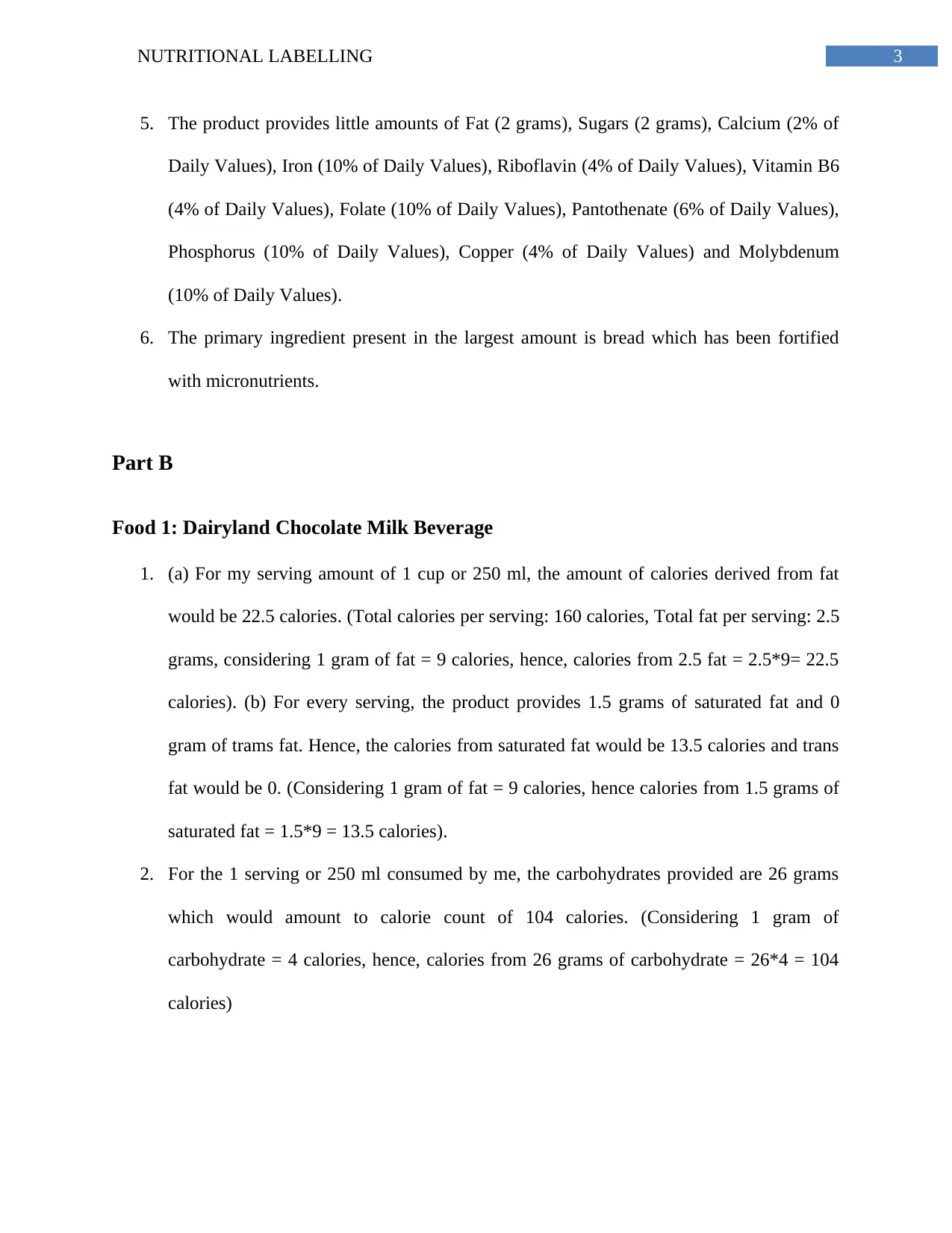
3NUTRITIONAL LABELLING
5. The product provides little amounts of Fat (2 grams), Sugars (2 grams), Calcium (2% of
Daily Values), Iron (10% of Daily Values), Riboflavin (4% of Daily Values), Vitamin B6
(4% of Daily Values), Folate (10% of Daily Values), Pantothenate (6% of Daily Values),
Phosphorus (10% of Daily Values), Copper (4% of Daily Values) and Molybdenum
(10% of Daily Values).
6. The primary ingredient present in the largest amount is bread which has been fortified
with micronutrients.
Part B
Food 1: Dairyland Chocolate Milk Beverage
1. (a) For my serving amount of 1 cup or 250 ml, the amount of calories derived from fat
would be 22.5 calories. (Total calories per serving: 160 calories, Total fat per serving: 2.5
grams, considering 1 gram of fat = 9 calories, hence, calories from 2.5 fat = 2.5*9= 22.5
calories). (b) For every serving, the product provides 1.5 grams of saturated fat and 0
gram of trams fat. Hence, the calories from saturated fat would be 13.5 calories and trans
fat would be 0. (Considering 1 gram of fat = 9 calories, hence calories from 1.5 grams of
saturated fat = 1.5*9 = 13.5 calories).
2. For the 1 serving or 250 ml consumed by me, the carbohydrates provided are 26 grams
which would amount to calorie count of 104 calories. (Considering 1 gram of
carbohydrate = 4 calories, hence, calories from 26 grams of carbohydrate = 26*4 = 104
calories)
5. The product provides little amounts of Fat (2 grams), Sugars (2 grams), Calcium (2% of
Daily Values), Iron (10% of Daily Values), Riboflavin (4% of Daily Values), Vitamin B6
(4% of Daily Values), Folate (10% of Daily Values), Pantothenate (6% of Daily Values),
Phosphorus (10% of Daily Values), Copper (4% of Daily Values) and Molybdenum
(10% of Daily Values).
6. The primary ingredient present in the largest amount is bread which has been fortified
with micronutrients.
Part B
Food 1: Dairyland Chocolate Milk Beverage
1. (a) For my serving amount of 1 cup or 250 ml, the amount of calories derived from fat
would be 22.5 calories. (Total calories per serving: 160 calories, Total fat per serving: 2.5
grams, considering 1 gram of fat = 9 calories, hence, calories from 2.5 fat = 2.5*9= 22.5
calories). (b) For every serving, the product provides 1.5 grams of saturated fat and 0
gram of trams fat. Hence, the calories from saturated fat would be 13.5 calories and trans
fat would be 0. (Considering 1 gram of fat = 9 calories, hence calories from 1.5 grams of
saturated fat = 1.5*9 = 13.5 calories).
2. For the 1 serving or 250 ml consumed by me, the carbohydrates provided are 26 grams
which would amount to calorie count of 104 calories. (Considering 1 gram of
carbohydrate = 4 calories, hence, calories from 26 grams of carbohydrate = 26*4 = 104
calories)
Paraphrase This Document
Need a fresh take? Get an instant paraphrase of this document with our AI Paraphraser
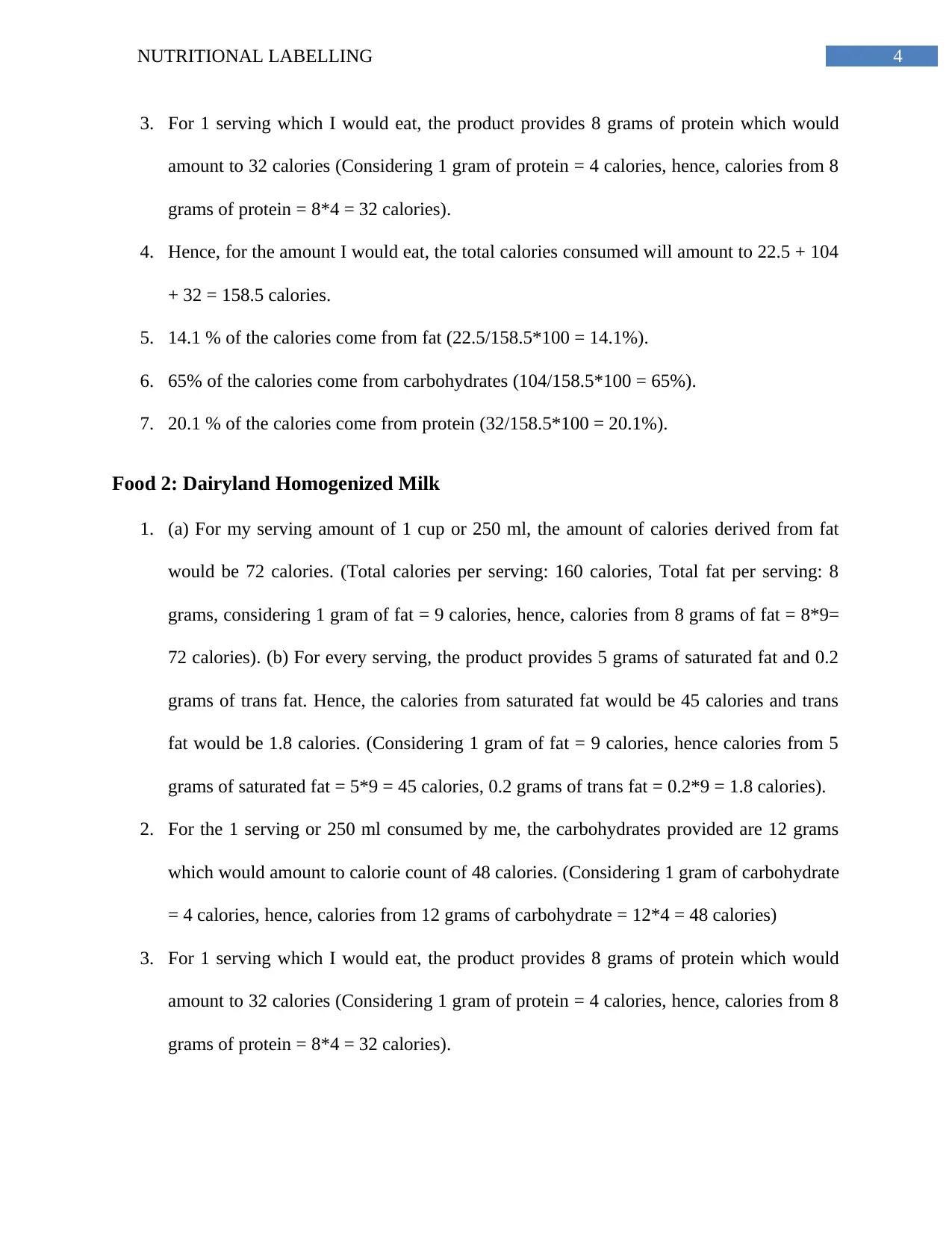
4NUTRITIONAL LABELLING
3. For 1 serving which I would eat, the product provides 8 grams of protein which would
amount to 32 calories (Considering 1 gram of protein = 4 calories, hence, calories from 8
grams of protein = 8*4 = 32 calories).
4. Hence, for the amount I would eat, the total calories consumed will amount to 22.5 + 104
+ 32 = 158.5 calories.
5. 14.1 % of the calories come from fat (22.5/158.5*100 = 14.1%).
6. 65% of the calories come from carbohydrates (104/158.5*100 = 65%).
7. 20.1 % of the calories come from protein (32/158.5*100 = 20.1%).
Food 2: Dairyland Homogenized Milk
1. (a) For my serving amount of 1 cup or 250 ml, the amount of calories derived from fat
would be 72 calories. (Total calories per serving: 160 calories, Total fat per serving: 8
grams, considering 1 gram of fat = 9 calories, hence, calories from 8 grams of fat = 8*9=
72 calories). (b) For every serving, the product provides 5 grams of saturated fat and 0.2
grams of trans fat. Hence, the calories from saturated fat would be 45 calories and trans
fat would be 1.8 calories. (Considering 1 gram of fat = 9 calories, hence calories from 5
grams of saturated fat = 5*9 = 45 calories, 0.2 grams of trans fat = 0.2*9 = 1.8 calories).
2. For the 1 serving or 250 ml consumed by me, the carbohydrates provided are 12 grams
which would amount to calorie count of 48 calories. (Considering 1 gram of carbohydrate
= 4 calories, hence, calories from 12 grams of carbohydrate = 12*4 = 48 calories)
3. For 1 serving which I would eat, the product provides 8 grams of protein which would
amount to 32 calories (Considering 1 gram of protein = 4 calories, hence, calories from 8
grams of protein = 8*4 = 32 calories).
3. For 1 serving which I would eat, the product provides 8 grams of protein which would
amount to 32 calories (Considering 1 gram of protein = 4 calories, hence, calories from 8
grams of protein = 8*4 = 32 calories).
4. Hence, for the amount I would eat, the total calories consumed will amount to 22.5 + 104
+ 32 = 158.5 calories.
5. 14.1 % of the calories come from fat (22.5/158.5*100 = 14.1%).
6. 65% of the calories come from carbohydrates (104/158.5*100 = 65%).
7. 20.1 % of the calories come from protein (32/158.5*100 = 20.1%).
Food 2: Dairyland Homogenized Milk
1. (a) For my serving amount of 1 cup or 250 ml, the amount of calories derived from fat
would be 72 calories. (Total calories per serving: 160 calories, Total fat per serving: 8
grams, considering 1 gram of fat = 9 calories, hence, calories from 8 grams of fat = 8*9=
72 calories). (b) For every serving, the product provides 5 grams of saturated fat and 0.2
grams of trans fat. Hence, the calories from saturated fat would be 45 calories and trans
fat would be 1.8 calories. (Considering 1 gram of fat = 9 calories, hence calories from 5
grams of saturated fat = 5*9 = 45 calories, 0.2 grams of trans fat = 0.2*9 = 1.8 calories).
2. For the 1 serving or 250 ml consumed by me, the carbohydrates provided are 12 grams
which would amount to calorie count of 48 calories. (Considering 1 gram of carbohydrate
= 4 calories, hence, calories from 12 grams of carbohydrate = 12*4 = 48 calories)
3. For 1 serving which I would eat, the product provides 8 grams of protein which would
amount to 32 calories (Considering 1 gram of protein = 4 calories, hence, calories from 8
grams of protein = 8*4 = 32 calories).
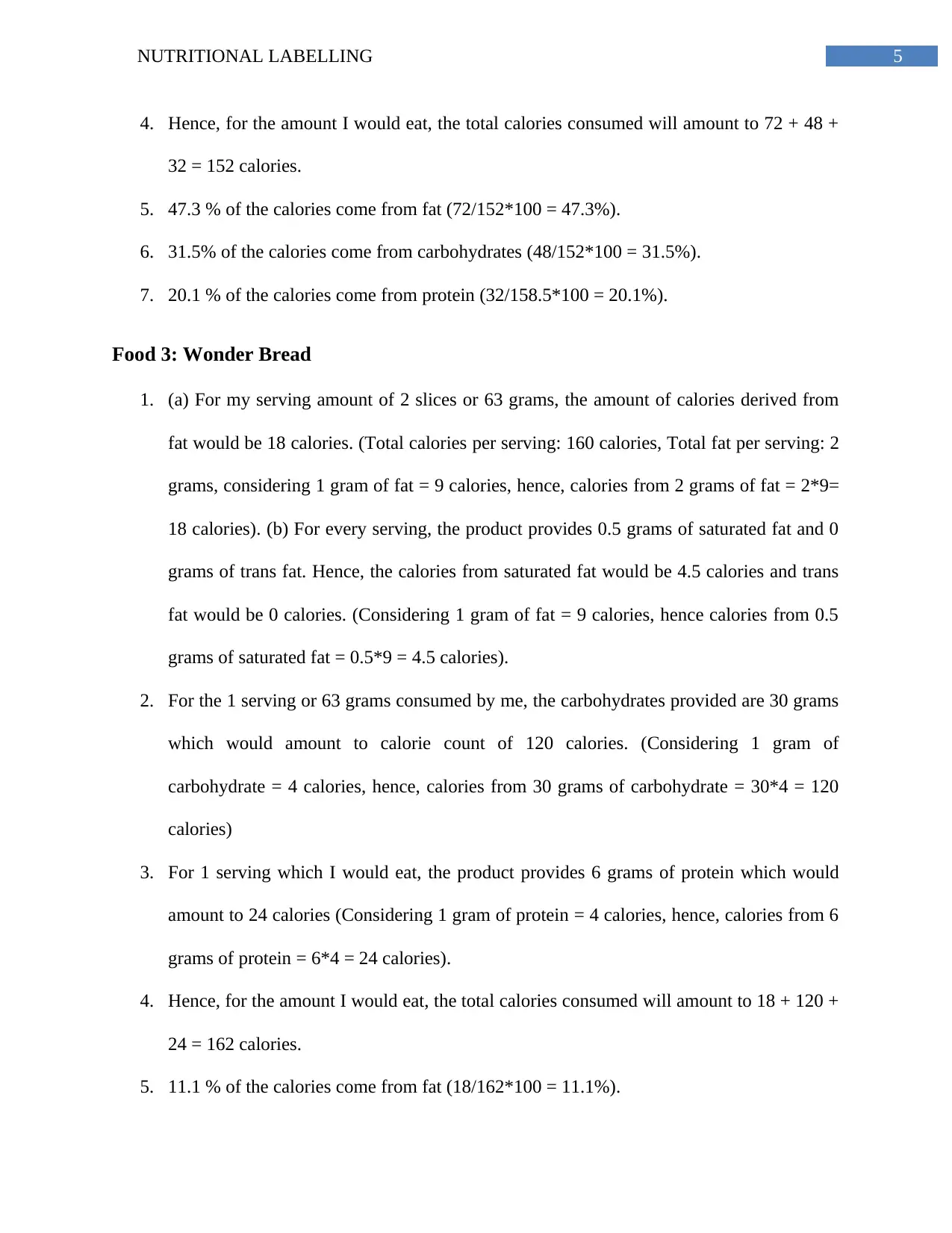
5NUTRITIONAL LABELLING
4. Hence, for the amount I would eat, the total calories consumed will amount to 72 + 48 +
32 = 152 calories.
5. 47.3 % of the calories come from fat (72/152*100 = 47.3%).
6. 31.5% of the calories come from carbohydrates (48/152*100 = 31.5%).
7. 20.1 % of the calories come from protein (32/158.5*100 = 20.1%).
Food 3: Wonder Bread
1. (a) For my serving amount of 2 slices or 63 grams, the amount of calories derived from
fat would be 18 calories. (Total calories per serving: 160 calories, Total fat per serving: 2
grams, considering 1 gram of fat = 9 calories, hence, calories from 2 grams of fat = 2*9=
18 calories). (b) For every serving, the product provides 0.5 grams of saturated fat and 0
grams of trans fat. Hence, the calories from saturated fat would be 4.5 calories and trans
fat would be 0 calories. (Considering 1 gram of fat = 9 calories, hence calories from 0.5
grams of saturated fat = 0.5*9 = 4.5 calories).
2. For the 1 serving or 63 grams consumed by me, the carbohydrates provided are 30 grams
which would amount to calorie count of 120 calories. (Considering 1 gram of
carbohydrate = 4 calories, hence, calories from 30 grams of carbohydrate = 30*4 = 120
calories)
3. For 1 serving which I would eat, the product provides 6 grams of protein which would
amount to 24 calories (Considering 1 gram of protein = 4 calories, hence, calories from 6
grams of protein = 6*4 = 24 calories).
4. Hence, for the amount I would eat, the total calories consumed will amount to 18 + 120 +
24 = 162 calories.
5. 11.1 % of the calories come from fat (18/162*100 = 11.1%).
4. Hence, for the amount I would eat, the total calories consumed will amount to 72 + 48 +
32 = 152 calories.
5. 47.3 % of the calories come from fat (72/152*100 = 47.3%).
6. 31.5% of the calories come from carbohydrates (48/152*100 = 31.5%).
7. 20.1 % of the calories come from protein (32/158.5*100 = 20.1%).
Food 3: Wonder Bread
1. (a) For my serving amount of 2 slices or 63 grams, the amount of calories derived from
fat would be 18 calories. (Total calories per serving: 160 calories, Total fat per serving: 2
grams, considering 1 gram of fat = 9 calories, hence, calories from 2 grams of fat = 2*9=
18 calories). (b) For every serving, the product provides 0.5 grams of saturated fat and 0
grams of trans fat. Hence, the calories from saturated fat would be 4.5 calories and trans
fat would be 0 calories. (Considering 1 gram of fat = 9 calories, hence calories from 0.5
grams of saturated fat = 0.5*9 = 4.5 calories).
2. For the 1 serving or 63 grams consumed by me, the carbohydrates provided are 30 grams
which would amount to calorie count of 120 calories. (Considering 1 gram of
carbohydrate = 4 calories, hence, calories from 30 grams of carbohydrate = 30*4 = 120
calories)
3. For 1 serving which I would eat, the product provides 6 grams of protein which would
amount to 24 calories (Considering 1 gram of protein = 4 calories, hence, calories from 6
grams of protein = 6*4 = 24 calories).
4. Hence, for the amount I would eat, the total calories consumed will amount to 18 + 120 +
24 = 162 calories.
5. 11.1 % of the calories come from fat (18/162*100 = 11.1%).
⊘ This is a preview!⊘
Do you want full access?
Subscribe today to unlock all pages.

Trusted by 1+ million students worldwide
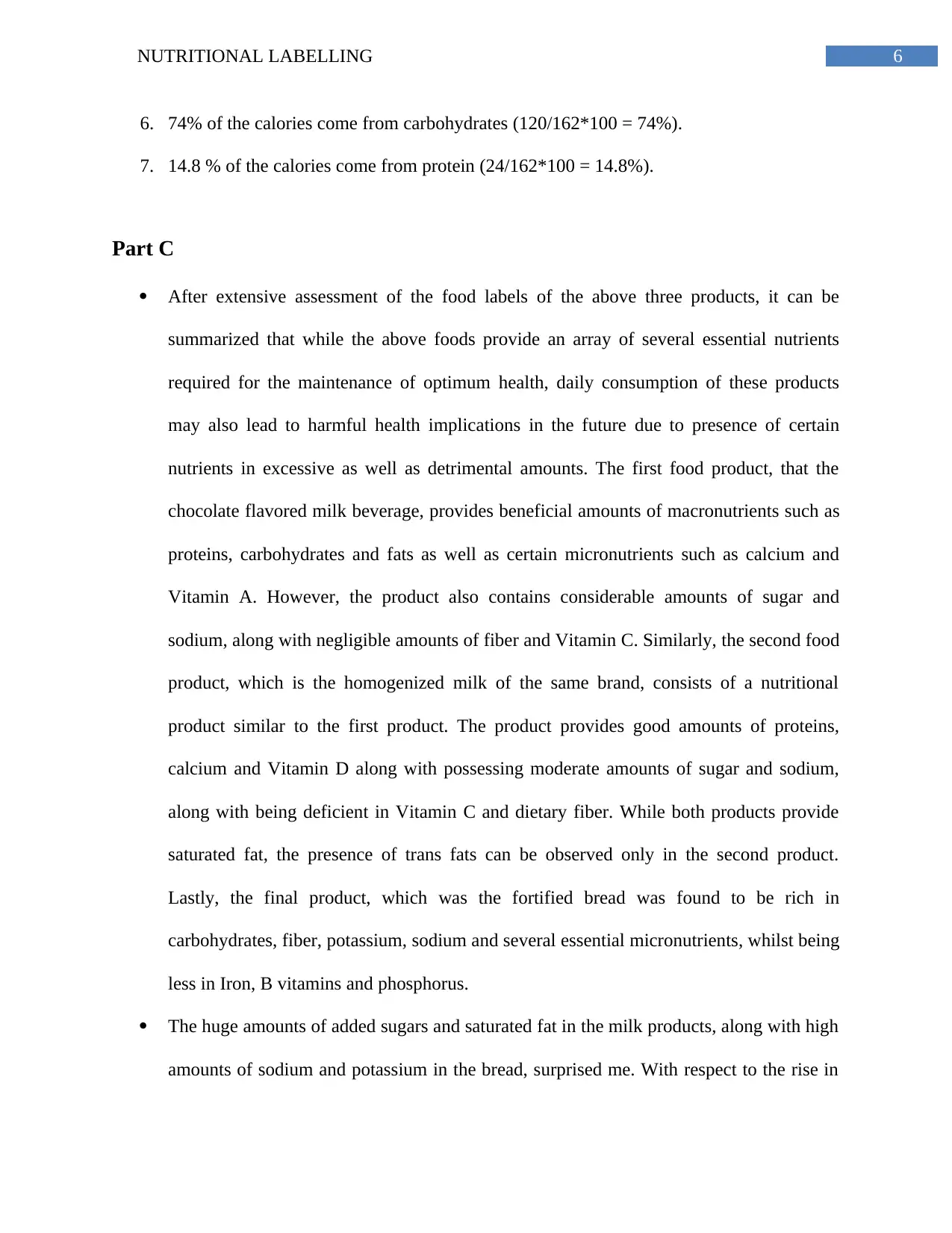
6NUTRITIONAL LABELLING
6. 74% of the calories come from carbohydrates (120/162*100 = 74%).
7. 14.8 % of the calories come from protein (24/162*100 = 14.8%).
Part C
After extensive assessment of the food labels of the above three products, it can be
summarized that while the above foods provide an array of several essential nutrients
required for the maintenance of optimum health, daily consumption of these products
may also lead to harmful health implications in the future due to presence of certain
nutrients in excessive as well as detrimental amounts. The first food product, that the
chocolate flavored milk beverage, provides beneficial amounts of macronutrients such as
proteins, carbohydrates and fats as well as certain micronutrients such as calcium and
Vitamin A. However, the product also contains considerable amounts of sugar and
sodium, along with negligible amounts of fiber and Vitamin C. Similarly, the second food
product, which is the homogenized milk of the same brand, consists of a nutritional
product similar to the first product. The product provides good amounts of proteins,
calcium and Vitamin D along with possessing moderate amounts of sugar and sodium,
along with being deficient in Vitamin C and dietary fiber. While both products provide
saturated fat, the presence of trans fats can be observed only in the second product.
Lastly, the final product, which was the fortified bread was found to be rich in
carbohydrates, fiber, potassium, sodium and several essential micronutrients, whilst being
less in Iron, B vitamins and phosphorus.
The huge amounts of added sugars and saturated fat in the milk products, along with high
amounts of sodium and potassium in the bread, surprised me. With respect to the rise in
6. 74% of the calories come from carbohydrates (120/162*100 = 74%).
7. 14.8 % of the calories come from protein (24/162*100 = 14.8%).
Part C
After extensive assessment of the food labels of the above three products, it can be
summarized that while the above foods provide an array of several essential nutrients
required for the maintenance of optimum health, daily consumption of these products
may also lead to harmful health implications in the future due to presence of certain
nutrients in excessive as well as detrimental amounts. The first food product, that the
chocolate flavored milk beverage, provides beneficial amounts of macronutrients such as
proteins, carbohydrates and fats as well as certain micronutrients such as calcium and
Vitamin A. However, the product also contains considerable amounts of sugar and
sodium, along with negligible amounts of fiber and Vitamin C. Similarly, the second food
product, which is the homogenized milk of the same brand, consists of a nutritional
product similar to the first product. The product provides good amounts of proteins,
calcium and Vitamin D along with possessing moderate amounts of sugar and sodium,
along with being deficient in Vitamin C and dietary fiber. While both products provide
saturated fat, the presence of trans fats can be observed only in the second product.
Lastly, the final product, which was the fortified bread was found to be rich in
carbohydrates, fiber, potassium, sodium and several essential micronutrients, whilst being
less in Iron, B vitamins and phosphorus.
The huge amounts of added sugars and saturated fat in the milk products, along with high
amounts of sodium and potassium in the bread, surprised me. With respect to the rise in
Paraphrase This Document
Need a fresh take? Get an instant paraphrase of this document with our AI Paraphraser
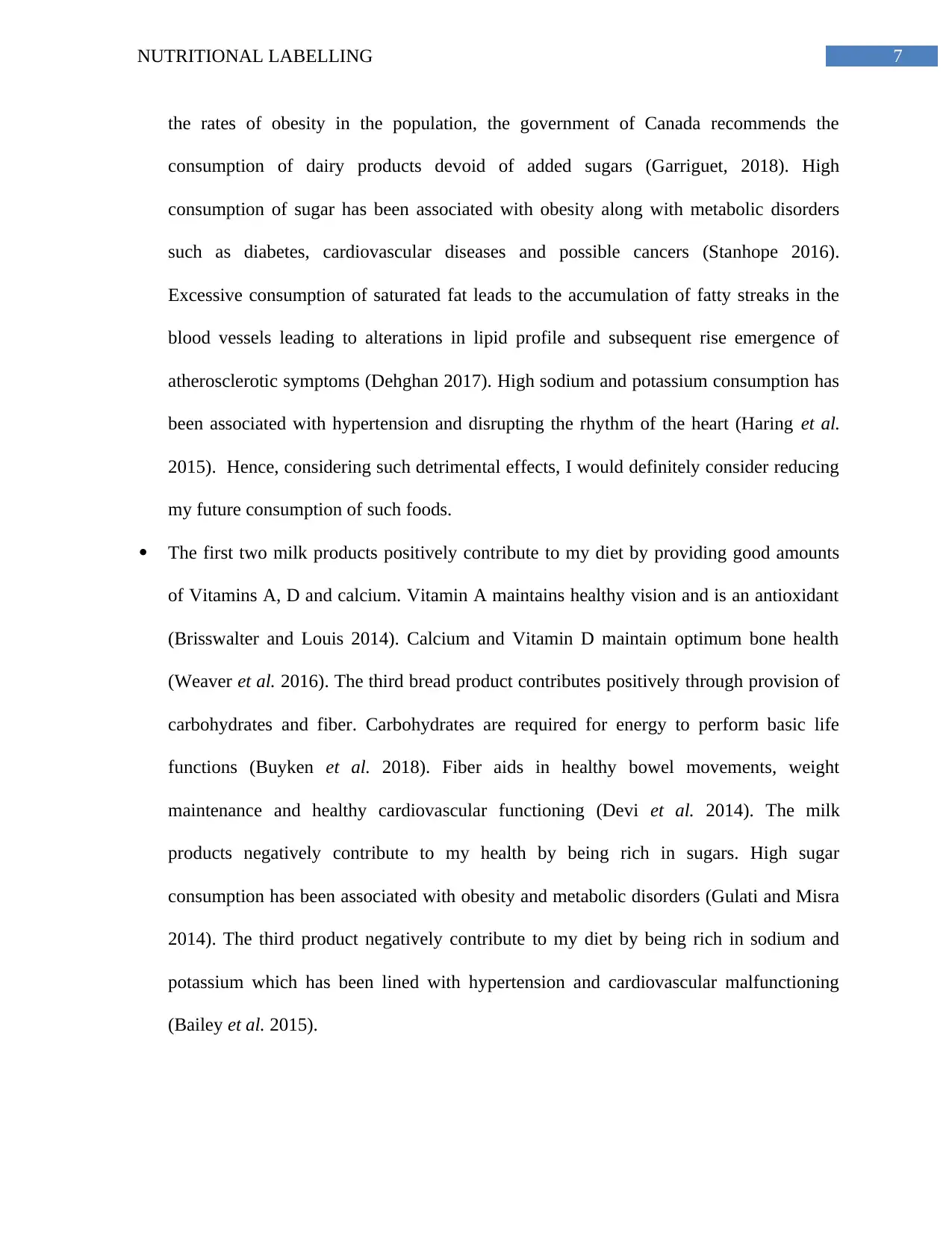
7NUTRITIONAL LABELLING
the rates of obesity in the population, the government of Canada recommends the
consumption of dairy products devoid of added sugars (Garriguet, 2018). High
consumption of sugar has been associated with obesity along with metabolic disorders
such as diabetes, cardiovascular diseases and possible cancers (Stanhope 2016).
Excessive consumption of saturated fat leads to the accumulation of fatty streaks in the
blood vessels leading to alterations in lipid profile and subsequent rise emergence of
atherosclerotic symptoms (Dehghan 2017). High sodium and potassium consumption has
been associated with hypertension and disrupting the rhythm of the heart (Haring et al.
2015). Hence, considering such detrimental effects, I would definitely consider reducing
my future consumption of such foods.
The first two milk products positively contribute to my diet by providing good amounts
of Vitamins A, D and calcium. Vitamin A maintains healthy vision and is an antioxidant
(Brisswalter and Louis 2014). Calcium and Vitamin D maintain optimum bone health
(Weaver et al. 2016). The third bread product contributes positively through provision of
carbohydrates and fiber. Carbohydrates are required for energy to perform basic life
functions (Buyken et al. 2018). Fiber aids in healthy bowel movements, weight
maintenance and healthy cardiovascular functioning (Devi et al. 2014). The milk
products negatively contribute to my health by being rich in sugars. High sugar
consumption has been associated with obesity and metabolic disorders (Gulati and Misra
2014). The third product negatively contribute to my diet by being rich in sodium and
potassium which has been lined with hypertension and cardiovascular malfunctioning
(Bailey et al. 2015).
the rates of obesity in the population, the government of Canada recommends the
consumption of dairy products devoid of added sugars (Garriguet, 2018). High
consumption of sugar has been associated with obesity along with metabolic disorders
such as diabetes, cardiovascular diseases and possible cancers (Stanhope 2016).
Excessive consumption of saturated fat leads to the accumulation of fatty streaks in the
blood vessels leading to alterations in lipid profile and subsequent rise emergence of
atherosclerotic symptoms (Dehghan 2017). High sodium and potassium consumption has
been associated with hypertension and disrupting the rhythm of the heart (Haring et al.
2015). Hence, considering such detrimental effects, I would definitely consider reducing
my future consumption of such foods.
The first two milk products positively contribute to my diet by providing good amounts
of Vitamins A, D and calcium. Vitamin A maintains healthy vision and is an antioxidant
(Brisswalter and Louis 2014). Calcium and Vitamin D maintain optimum bone health
(Weaver et al. 2016). The third bread product contributes positively through provision of
carbohydrates and fiber. Carbohydrates are required for energy to perform basic life
functions (Buyken et al. 2018). Fiber aids in healthy bowel movements, weight
maintenance and healthy cardiovascular functioning (Devi et al. 2014). The milk
products negatively contribute to my health by being rich in sugars. High sugar
consumption has been associated with obesity and metabolic disorders (Gulati and Misra
2014). The third product negatively contribute to my diet by being rich in sodium and
potassium which has been lined with hypertension and cardiovascular malfunctioning
(Bailey et al. 2015).
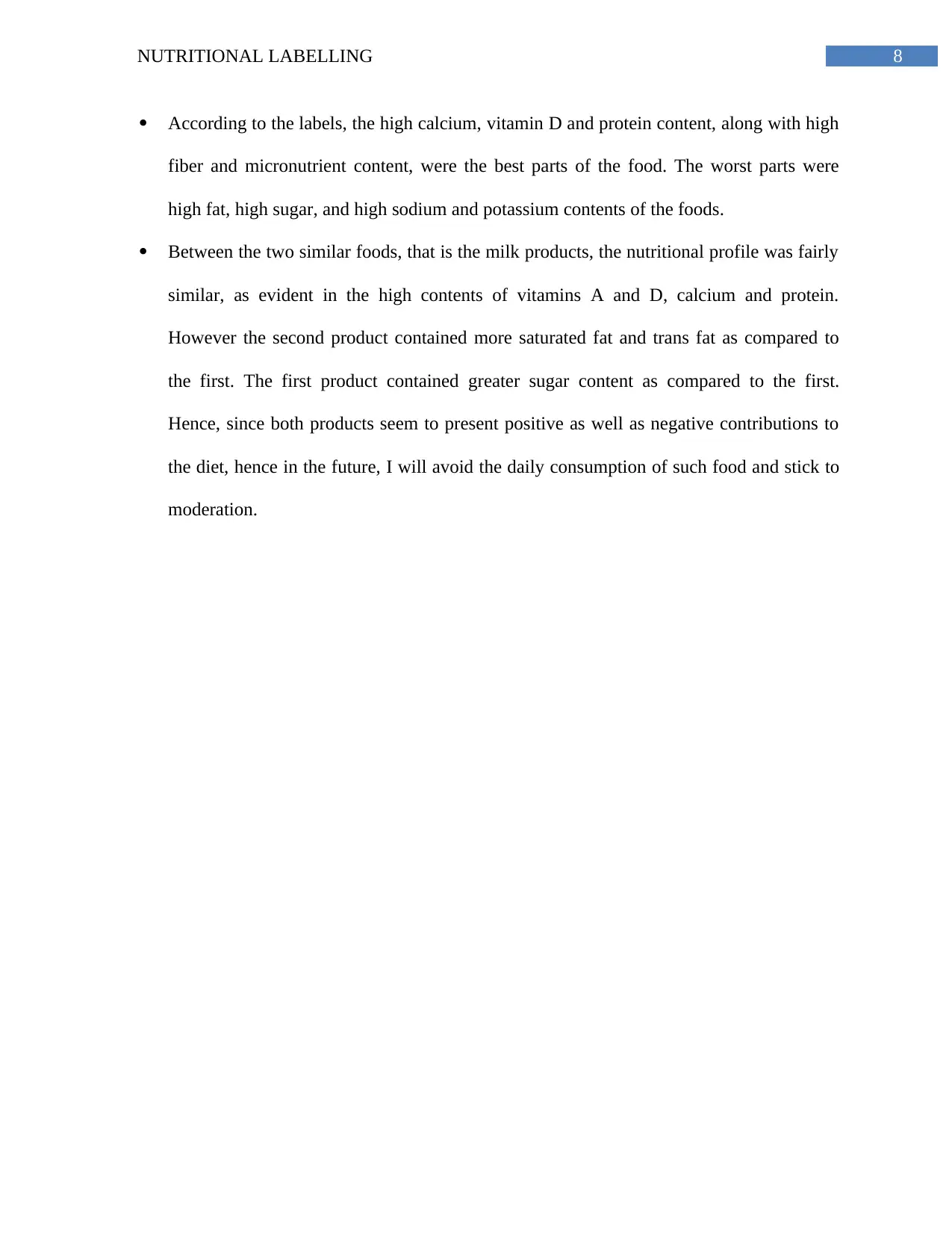
8NUTRITIONAL LABELLING
According to the labels, the high calcium, vitamin D and protein content, along with high
fiber and micronutrient content, were the best parts of the food. The worst parts were
high fat, high sugar, and high sodium and potassium contents of the foods.
Between the two similar foods, that is the milk products, the nutritional profile was fairly
similar, as evident in the high contents of vitamins A and D, calcium and protein.
However the second product contained more saturated fat and trans fat as compared to
the first. The first product contained greater sugar content as compared to the first.
Hence, since both products seem to present positive as well as negative contributions to
the diet, hence in the future, I will avoid the daily consumption of such food and stick to
moderation.
According to the labels, the high calcium, vitamin D and protein content, along with high
fiber and micronutrient content, were the best parts of the food. The worst parts were
high fat, high sugar, and high sodium and potassium contents of the foods.
Between the two similar foods, that is the milk products, the nutritional profile was fairly
similar, as evident in the high contents of vitamins A and D, calcium and protein.
However the second product contained more saturated fat and trans fat as compared to
the first. The first product contained greater sugar content as compared to the first.
Hence, since both products seem to present positive as well as negative contributions to
the diet, hence in the future, I will avoid the daily consumption of such food and stick to
moderation.
⊘ This is a preview!⊘
Do you want full access?
Subscribe today to unlock all pages.

Trusted by 1+ million students worldwide
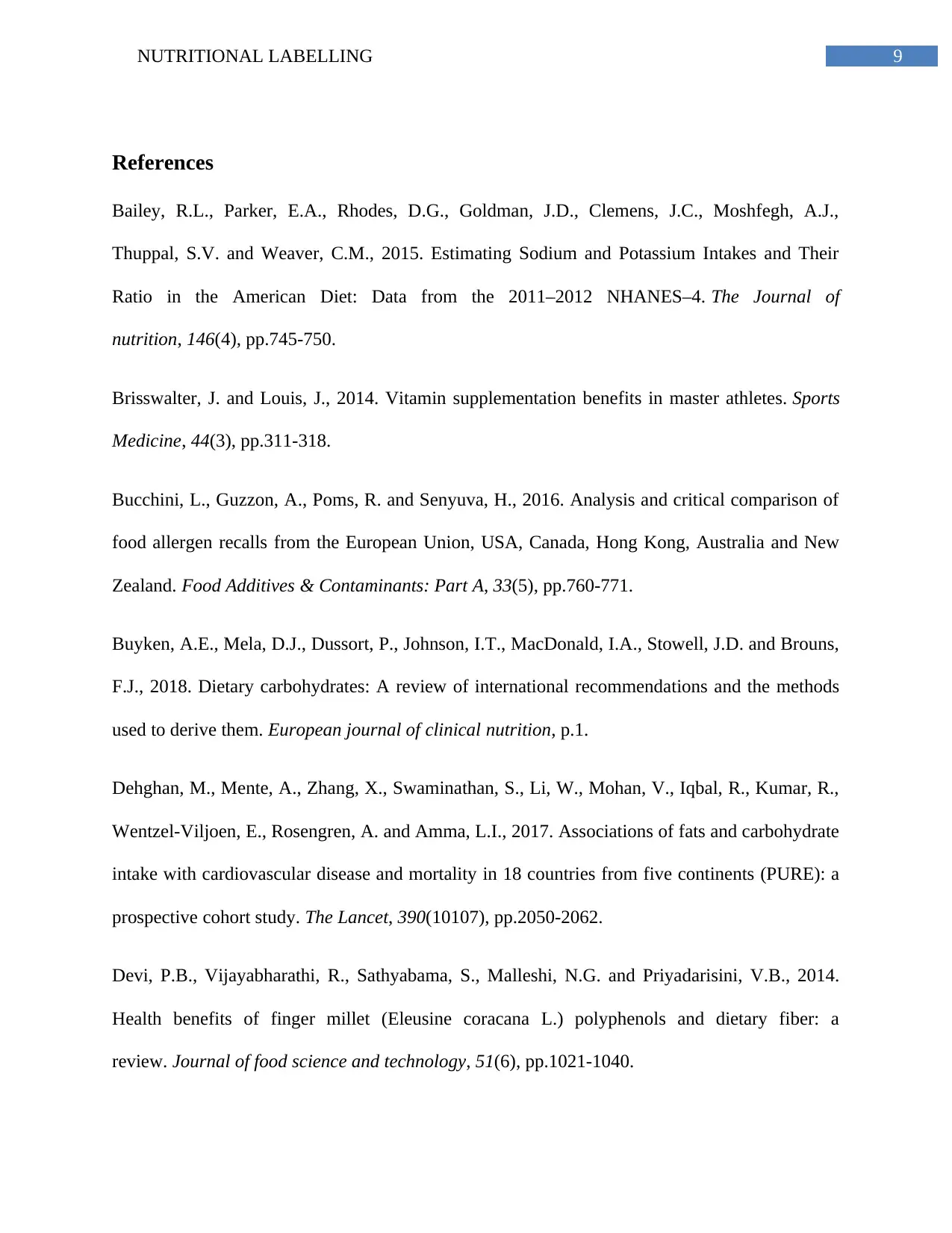
9NUTRITIONAL LABELLING
References
Bailey, R.L., Parker, E.A., Rhodes, D.G., Goldman, J.D., Clemens, J.C., Moshfegh, A.J.,
Thuppal, S.V. and Weaver, C.M., 2015. Estimating Sodium and Potassium Intakes and Their
Ratio in the American Diet: Data from the 2011–2012 NHANES–4. The Journal of
nutrition, 146(4), pp.745-750.
Brisswalter, J. and Louis, J., 2014. Vitamin supplementation benefits in master athletes. Sports
Medicine, 44(3), pp.311-318.
Bucchini, L., Guzzon, A., Poms, R. and Senyuva, H., 2016. Analysis and critical comparison of
food allergen recalls from the European Union, USA, Canada, Hong Kong, Australia and New
Zealand. Food Additives & Contaminants: Part A, 33(5), pp.760-771.
Buyken, A.E., Mela, D.J., Dussort, P., Johnson, I.T., MacDonald, I.A., Stowell, J.D. and Brouns,
F.J., 2018. Dietary carbohydrates: A review of international recommendations and the methods
used to derive them. European journal of clinical nutrition, p.1.
Dehghan, M., Mente, A., Zhang, X., Swaminathan, S., Li, W., Mohan, V., Iqbal, R., Kumar, R.,
Wentzel-Viljoen, E., Rosengren, A. and Amma, L.I., 2017. Associations of fats and carbohydrate
intake with cardiovascular disease and mortality in 18 countries from five continents (PURE): a
prospective cohort study. The Lancet, 390(10107), pp.2050-2062.
Devi, P.B., Vijayabharathi, R., Sathyabama, S., Malleshi, N.G. and Priyadarisini, V.B., 2014.
Health benefits of finger millet (Eleusine coracana L.) polyphenols and dietary fiber: a
review. Journal of food science and technology, 51(6), pp.1021-1040.
References
Bailey, R.L., Parker, E.A., Rhodes, D.G., Goldman, J.D., Clemens, J.C., Moshfegh, A.J.,
Thuppal, S.V. and Weaver, C.M., 2015. Estimating Sodium and Potassium Intakes and Their
Ratio in the American Diet: Data from the 2011–2012 NHANES–4. The Journal of
nutrition, 146(4), pp.745-750.
Brisswalter, J. and Louis, J., 2014. Vitamin supplementation benefits in master athletes. Sports
Medicine, 44(3), pp.311-318.
Bucchini, L., Guzzon, A., Poms, R. and Senyuva, H., 2016. Analysis and critical comparison of
food allergen recalls from the European Union, USA, Canada, Hong Kong, Australia and New
Zealand. Food Additives & Contaminants: Part A, 33(5), pp.760-771.
Buyken, A.E., Mela, D.J., Dussort, P., Johnson, I.T., MacDonald, I.A., Stowell, J.D. and Brouns,
F.J., 2018. Dietary carbohydrates: A review of international recommendations and the methods
used to derive them. European journal of clinical nutrition, p.1.
Dehghan, M., Mente, A., Zhang, X., Swaminathan, S., Li, W., Mohan, V., Iqbal, R., Kumar, R.,
Wentzel-Viljoen, E., Rosengren, A. and Amma, L.I., 2017. Associations of fats and carbohydrate
intake with cardiovascular disease and mortality in 18 countries from five continents (PURE): a
prospective cohort study. The Lancet, 390(10107), pp.2050-2062.
Devi, P.B., Vijayabharathi, R., Sathyabama, S., Malleshi, N.G. and Priyadarisini, V.B., 2014.
Health benefits of finger millet (Eleusine coracana L.) polyphenols and dietary fiber: a
review. Journal of food science and technology, 51(6), pp.1021-1040.
Paraphrase This Document
Need a fresh take? Get an instant paraphrase of this document with our AI Paraphraser
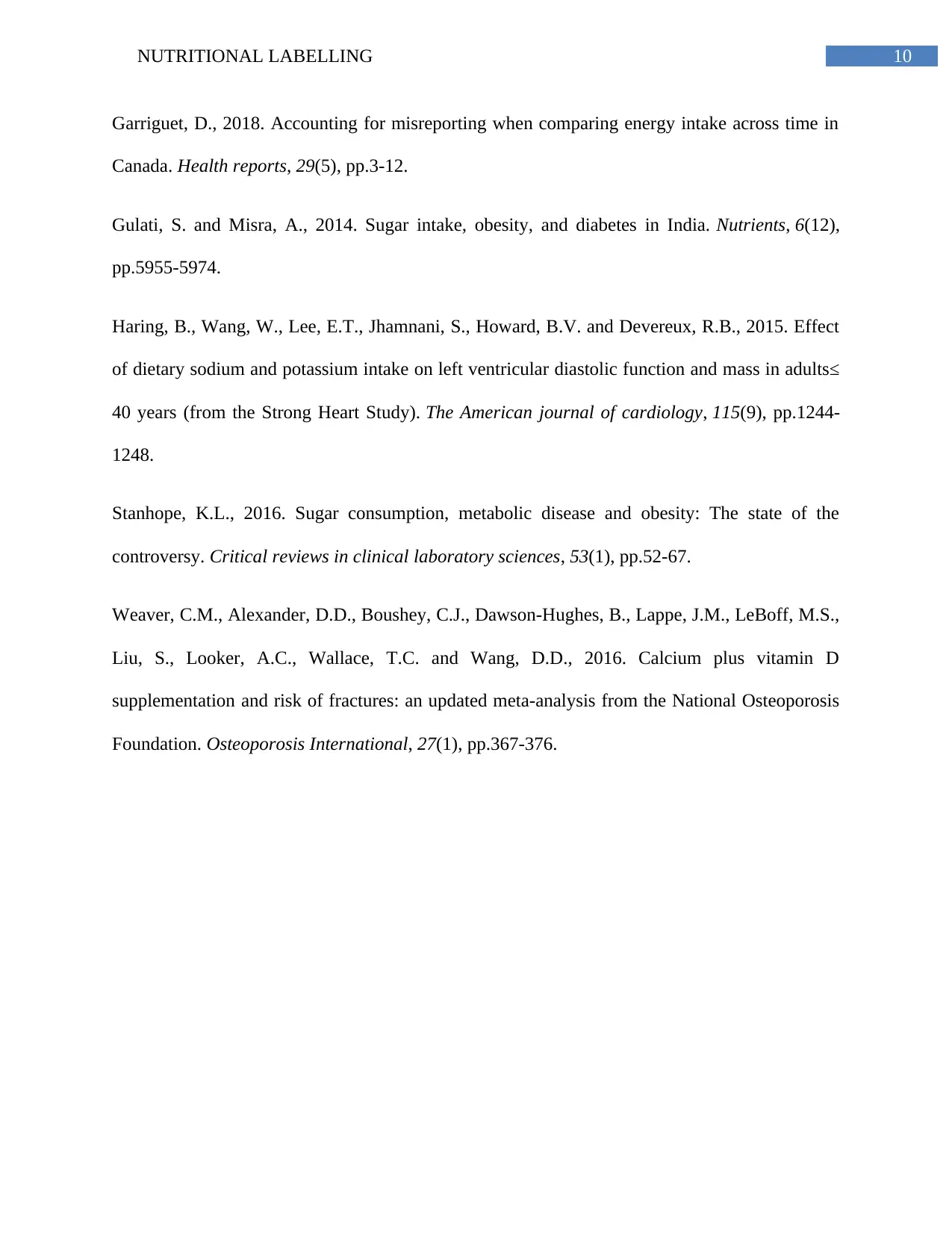
10NUTRITIONAL LABELLING
Garriguet, D., 2018. Accounting for misreporting when comparing energy intake across time in
Canada. Health reports, 29(5), pp.3-12.
Gulati, S. and Misra, A., 2014. Sugar intake, obesity, and diabetes in India. Nutrients, 6(12),
pp.5955-5974.
Haring, B., Wang, W., Lee, E.T., Jhamnani, S., Howard, B.V. and Devereux, R.B., 2015. Effect
of dietary sodium and potassium intake on left ventricular diastolic function and mass in adults≤
40 years (from the Strong Heart Study). The American journal of cardiology, 115(9), pp.1244-
1248.
Stanhope, K.L., 2016. Sugar consumption, metabolic disease and obesity: The state of the
controversy. Critical reviews in clinical laboratory sciences, 53(1), pp.52-67.
Weaver, C.M., Alexander, D.D., Boushey, C.J., Dawson-Hughes, B., Lappe, J.M., LeBoff, M.S.,
Liu, S., Looker, A.C., Wallace, T.C. and Wang, D.D., 2016. Calcium plus vitamin D
supplementation and risk of fractures: an updated meta-analysis from the National Osteoporosis
Foundation. Osteoporosis International, 27(1), pp.367-376.
Garriguet, D., 2018. Accounting for misreporting when comparing energy intake across time in
Canada. Health reports, 29(5), pp.3-12.
Gulati, S. and Misra, A., 2014. Sugar intake, obesity, and diabetes in India. Nutrients, 6(12),
pp.5955-5974.
Haring, B., Wang, W., Lee, E.T., Jhamnani, S., Howard, B.V. and Devereux, R.B., 2015. Effect
of dietary sodium and potassium intake on left ventricular diastolic function and mass in adults≤
40 years (from the Strong Heart Study). The American journal of cardiology, 115(9), pp.1244-
1248.
Stanhope, K.L., 2016. Sugar consumption, metabolic disease and obesity: The state of the
controversy. Critical reviews in clinical laboratory sciences, 53(1), pp.52-67.
Weaver, C.M., Alexander, D.D., Boushey, C.J., Dawson-Hughes, B., Lappe, J.M., LeBoff, M.S.,
Liu, S., Looker, A.C., Wallace, T.C. and Wang, D.D., 2016. Calcium plus vitamin D
supplementation and risk of fractures: an updated meta-analysis from the National Osteoporosis
Foundation. Osteoporosis International, 27(1), pp.367-376.
1 out of 11
Related Documents
Your All-in-One AI-Powered Toolkit for Academic Success.
+13062052269
info@desklib.com
Available 24*7 on WhatsApp / Email
![[object Object]](/_next/static/media/star-bottom.7253800d.svg)
Unlock your academic potential
Copyright © 2020–2025 A2Z Services. All Rights Reserved. Developed and managed by ZUCOL.




